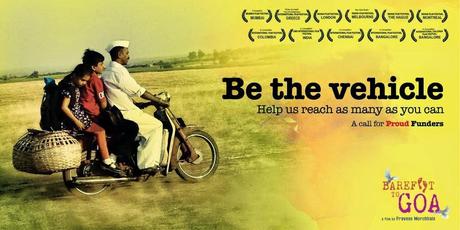Here is a Q and A Session with Director Praveen Morchhale,
Q. Your film is visually very lyrical and you have given a lot emphasis on landscape. Why?
A. I had a very specific visual plan so that the film becomes a visual poetic in narration. I tried to embrace the landscape in the film as its core element and character. I used the dryness of outdoor as a reflection of our family and society. Every background of the film has a layered meaning reflecting the character’s mind and emotions. Long panoramic shots with complexity and simplicity are used to capture the essence and spice of life.

Q. Barefoot to Goa is a very realistic and shuttle in expressions. Was it consciously decided?
A. My film is simple but not a simplistic film. It is layered with many philosophical inferences. Silently it raises many philosophical questions without giving answers. It was really hard to make it less verbal and realistic in narration and composition.
Q. In many scenes, characters are invisible and still their presence is felt. Why this kind of treatment?
A. In the climax and long shots, consciously I have mentioned distance from characters or they are almost absent, so the audience can relate more on the characters fate and situation and this way an imaginary hope and despair is created in the minds of audience and many interpretations can be drawn.
Q. You have used almost all non-actors including children baring one or two actors. Was it not scary, as you being the first-time director?
A. It was conscious and determined decision. I believed non-actors have only real experience of life to express, thus for them it is not a job. It was easy to portray the slice of life kind expressions by non-actors. They were just being themselves, just like they are in everyday life. For example, I persuaded a real deaf and dumb couple to act as a deaf and dumb farmer couple, to get almost perfect expressions and they left a perfect expression. Non-actors made my film special.
Q. Why you used minimalist approach towards dialogues in the film?
A. When the film can speak visually then where is the need to use the words? In fact, silence itself is a character in the film and it raises concern about the way we have relationships and behave in society. In the film, silence hovers around the narrative like a shadow, impossible to shrug away. The film`s protagonist silently explores and experiences the contradictions of the contemporary society.
Q. Barefoot to Goa has children as protagonists but still film`s main theme is for adults. Is it a children film for adults?
A. I believe film works at many levels. For simple joy of trave and innocence, love for elders, it suits for children as they would love it for its fun and travel element. But as we look deeper into the meaning of the subject and theme, film explores the nuances of loneliness of urban life, dryness of relationships and neglect of elders. Philosophically it makes us think about futility of life and pointlessness of death. Film raises more questions than the answers,. It explores landscape of life`s colors, rhythm and harsh realities
Q. It’s not strange that during such a long journey children never met any bad element of the society? They always met good people who helped them. Where in reality this may be untrue…
A. Why should we have negative aspects in our day-to-day life? From morning to evening we see all bad news, bad things happening to children and women. I don’t like such things and would not like to show in my film. It was conscious decision to keep away from such bad elements from story and narrative. My all characters are humble and victims of circumstances. As such they are not bad. I tried to show the positive side of the people.
Q. Film’s climax is very tragic and slightly ambiguous. Don’t you feel a positive climax would’ve been better for the film?
A.Film’s climax embraces the uncertainty of life. Climax raises many questions for which there are no easy answers. Old age could be a metaphor. I used wooden spinner in the film as metaphor of life and death, as well as for lost traditions and culture in the race of materialist individualistic life. Film must hurt us and in my opinion climax hurts. That was the intention.
Q. In one sentence how would you define your film Barefoot to Goa?
A. It’s a bright film about sadness!
Q. Why do you call it Proud Funding ?
A. For film’s theatrical release, the funding is coming from well-wishers, friends, family and cinema lovers who don’t know me personally but have great love for good cinema and loving the Barefoot to Goa. How come my supporters can be crowd, who all have their identities, opinions, standing on issues and who are much smarter than the filmmakers? Supporters and contributors of Barefoot to Goa feeling very proud being with us and we also feel very proud having their support. We all want that good cinema must win which is soulful, very relevant and touches our hearts. Therefore it is PROUD FUNDING.
Here is a trailer for Barefoot to Goa
